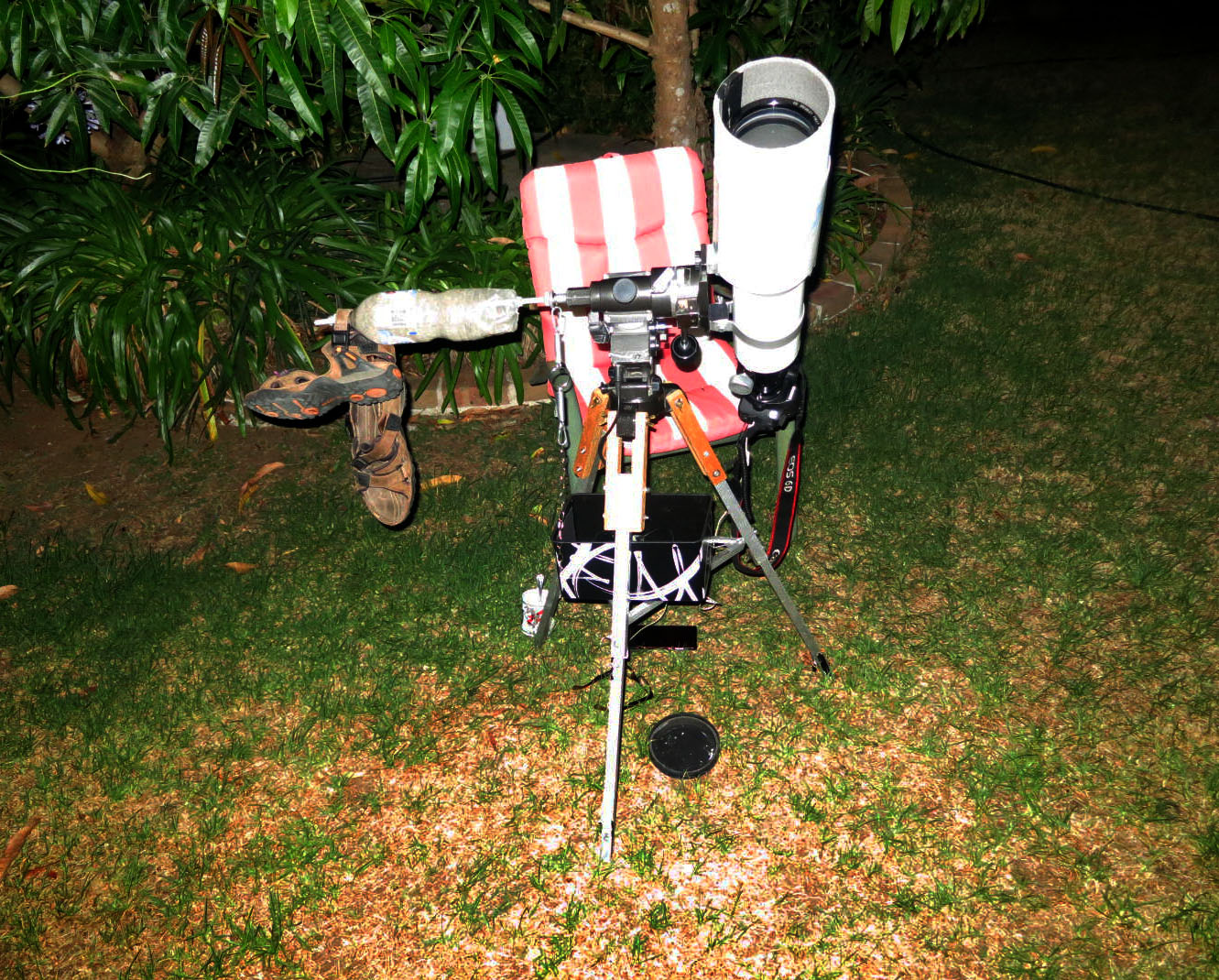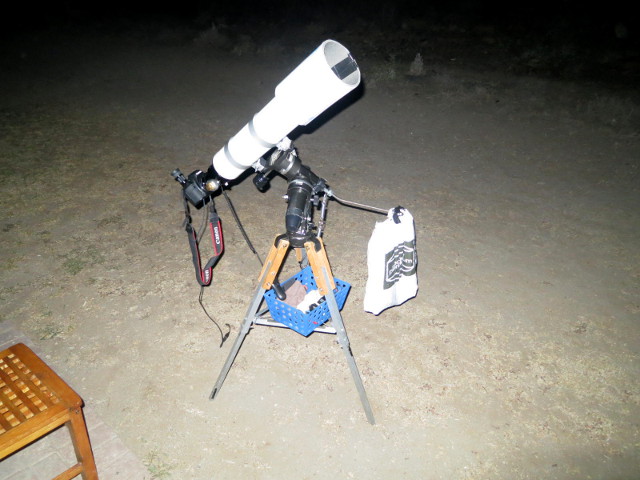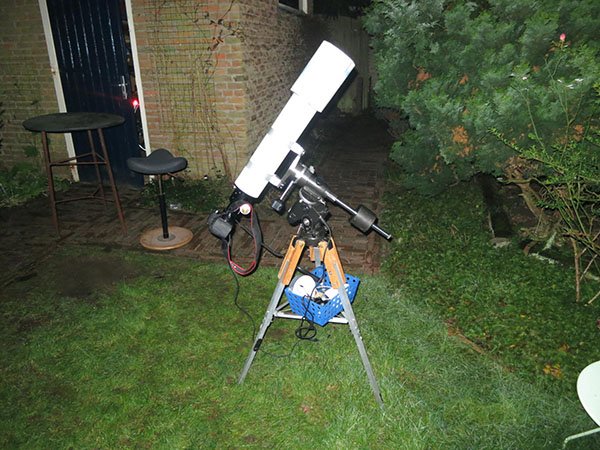- Index page with recent astrophotos
- Leeuwenboschfontein weekend starparty 2016 Mar 4-6
- Events observed by me from 2003 latest: Mercury transit 2016 May 9
- > Page with sky pictures with the EOS 6
- Lunar and planetary images and phenomenas
- Page with sky pictures with the EOS 40 from Bali jan 2009, feb 2010 and 2012
- Page with sky pictures from La Palma Jan / Feb 2011
- Total lunar eclipse of 2011 Jun 15
- Solar eclipse visible as deep partial in Indonesia on 2009 Jan 26
- Old 1973 Polarex 80mm spotting scope refurbishment.
- New 2015 Robtics ED110 refractor
- Using a telephoto lens as a small handheld telescope
- Nice sky pictures taken from a plane in full flight
- How to see stars in the daytime ?
- Old astrophotos from 1980-1990s
- How I learned Astronomy
- Astronomik CLS filter test
- Simple Eclipse calculations
Sky images taken with the EOS 6 and EOS R6Currently I do not have an astrocamera yet, I use DSLRs. Unmodded because my fullframe DSLRs have enough sensitivity to compensate for the dim (25%) Halpha signal which reaches the sensor, in post processing. In Sept 2021 I got the EOS R6 mirrorless. I got this camera on 1 Jan 2014 as an upgrade for the EOS 7 as this more 'affordable' full frame has much better noise characteristics than the APS-C models like the EOS 40 and 7. And after four years, it is still one of the best performers and its successor EOS 6 Mk2 released in August 2017 does not appear to be better. UPDATE 
In 2015 I made new images using the new ED110 telescope and the new Canon EF 200mm f/2.8L lens which is an excellent lens which is sharp to the corners on a full frame sensor, even at full aperture. For photos involving emission nebulas I used the Astronomik UHC-E full frame clip in filter for boosting the OIII and Halpha light in the nebulas. After processing, it remarkably reveals the red Halpha nebulas, despite my camera is not modified, which means that is has only 25% Halpha senssitivity. Some wide field images taken with the Samyang 14mm taken in Jan 2016 I have enhanced by subtracting the usual yellowish light pollution color from the background which enhances the contrast considerably. The foreground edges are sometimes poorly rendered, because with a foreground it is brutally difficult to separate foreground from sky background. End February 2016 I spent a week in Olive Grove a nice guesthouse on a very dark location 20km south of Beaufort West, South Africa. The sky is pitch dark, except a very small light dome low in the North from the high light poles in the townships of Beaufort West. All images made between 2015 Feb 10 and Mar 5 are made from dark (Bortle 3 or less) locations in Western Cape in South Africa. Those from 10-15 February and Feb 25-27 in a location 5km south of Tulbagh and the others between these dates in Bushmanspad cottages (winery) 20km east of Ashton, Western Cape, not far from R60. Actually a Bortle 2 location. The biggest problem I have to cope with in Holland are the orange skies, as the Netherlands is the country with the most illuminated sky of the world. The orange glow is due to the sodium lamps used for street lighting, but, even worse, upward lighting for lighting buildings of which more light does not reach the building at all. All images are shot in RAW (5472x3648) or sRAW (2736x1824) on the EOS 6 and processed by Photoshop CS6 and the open source darktable RAW processing app and the stacked ones by the freeware Deep sky stacker before using photoshop. Earlier photos taken with the EOS 40 and 7 are displayed in this page. In the past (1988-1997) I also did a lot with astrophotos with the Canon T90, for picures see here. 
 The first photos I have taken are with the nice Samyang 14mm f/2.8 which has an amazing image quality and wide angle. On Feb 4 I took photos of M42 and the Horsehead with 30 frames of 30 seconds each in the 100mm (f=500mm) Televue Genesis using an Astronomik CLS filter at 6400 ASA. However as I set the white balance to custom with strong red, the red was boosted with 2 stops resulting in a somewhat grainy red despite the very low grain of the EOS 6. The Astronomik filter also destroys some color rendering. | ||||||||||||||||||||||||||||||||||||||||||||||||||||||||||||||||||||||||||||||||||||||||||||||||||||||||||||
|
| ||||||||||||||||||||||||||||||||||||||||||||||||||||||||||||||||||||||||||||||||||||||||||||||||||||||||||||
Widefield picturesThese pictures are taken with the Samyang 14mm f/2.8 Sutherland of 24 Feb 2014. and the others on 22 Feb 2018 from o'Connell NSW Australia with the same lens, 30 sec on f/4. | ||||||||||||||||||||||||||||||||||||||||||||||||||||||||||||||||||||||||||||||||||||||||||||||||||||||||||||
|
| ||||||||||||||||||||||||||||||||||||||||||||||||||||||||||||||||||||||||||||||||||||||||||||||||||||||||||||